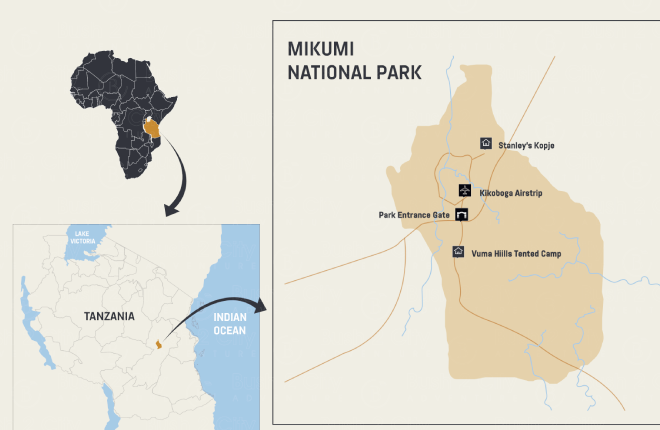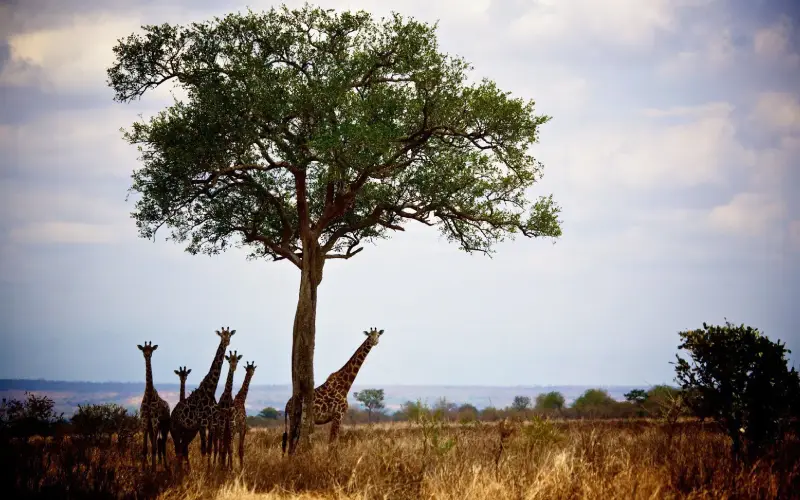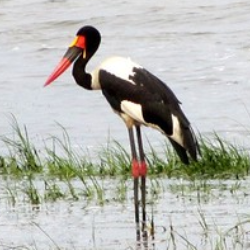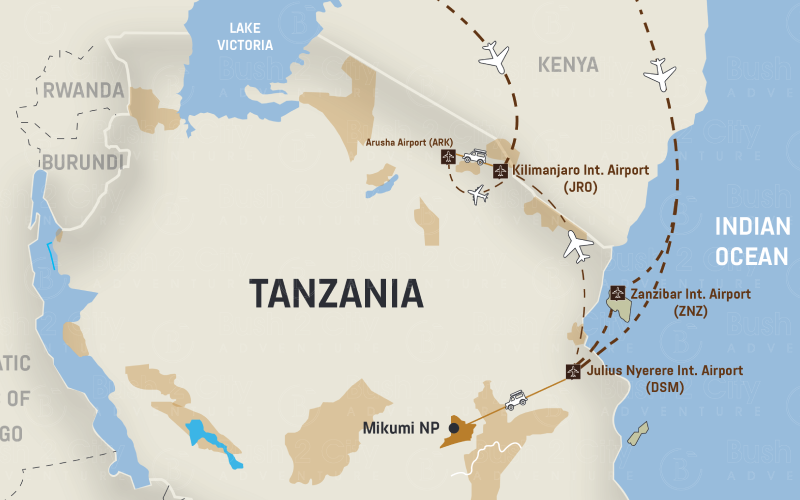Maliwaza a renowned Safari Expert, has helped thousands of travelers experience the magic of Tanzania, including the iconic Great Migration in the Serengeti.


Maliwaza a renowned Safari Expert, has helped thousands of travelers experience the magic of Tanzania, including the iconic Great Migration in the Serengeti.
Mikumi National Park boasts diverse wildlife, including large herds of zebras, wildebeests, buffaloes, impalas, giraffes, and elephants. Predators like lions and leopards are common, while hyenas are less often seen. Unique antelopes like elands, greater kudus, sables, and hartebeests roam the park. Baboons and vervet monkeys are also abundant. Excitingly, rhinos are planned to be reintroduced, further enriching the park’s biodiversity.
Mikumi’s waterholes offer an incredible wildlife show, with large herds of elephants, buffaloes, zebras, and wildebeests coming to drink, often alongside hippos. The park’s open grasslands are perfect for spotting elands, the largest antelope in the world. In the hilly woodlands, you can find the majestic greater kudus and sable antelopes, along with the rare Lichtenstein’s hartebeest. Playful baboons and vervet monkeys are also commonly seen. Plus, with plans to reintroduce rhinos, Mikumi is set to become an even more exciting destination for safari enthusiasts.
The ideal time to experience Mikumi National Park is during the Dry Season (June to October). With less dense vegetation, wildlife spotting becomes easier, especially in September and October when animals gather around waterholes. While the Wet Season (November to May) is less ideal for wildlife viewing, it’s a birder’s paradise.

Maliwaza a renowned Safari Expert, has helped thousands of travelers experience the magic of Tanzania, including the iconic Great Migration in the Serengeti.





Mikumi offers fantastic birdwatching year-round, with the best time being from November to April when migratory birds flock to the park. During this period, resident birds are also at their most vibrant, donning their breeding plumage. Keep in mind that the heavy rains in March and April can make birdwatching a bit more challenging. If you’re focused on wildlife viewing, the Dry Season (June to October) is the ideal time to spot animals, as the weather is more favorable.
450+
Nov to Apr
Maliwaza a renowned Safari Expert, has helped thousands of travelers experience the magic of Tanzania, including the iconic Great Migration in the Serengeti.

Maliwaza a renowned Safari Expert, has helped thousands of travelers experience the magic of Tanzania, including the iconic Great Migration in the Serengeti.
Dry Season (June to October). Pleasant Temperatures: Enjoy warm afternoons around 28°C (82°F) and cool nights around 17°C (63°F).
Sunny Skies: Expect clear, sunny days with minimal rainfall. October Transition: Rainfall may start in late October, marking the beginning of the wet season.
Wet Season (November to May). November & December: The wet season begins, with occasional afternoon thunderstorms.
January & February: More frequent rainfall with afternoon showers. March, April, & May: Peak wet season with frequent rain showers, especially in April.
Temperatures: Daytime: Around 31°C (88°F). Nighttime: Around 20°C (68°F)
Note: While it’s the wet season, heavy, all-day rain is uncommon.

Maliwaza a renowned Safari Expert, has helped thousands of travelers experience the magic of Tanzania, including the iconic Great Migration in the Serengeti.
Most safaris to Mikumi National Park begin in Dar es Salaam, with Julius Nyerere International Airport (DAR) being the main entry point into Tanzania.
You can also fly to Mikumi via charter flights from nearby locations like Nyerere (formerly Selous Game Reserve), Ruaha National Park, Dar es Salaam, and Zanzibar. Some flights are available from parks in Tanzania’s Northern Circuit as well.
By road, *Mikumi is about a 6-hour drive (300 km/186 miles) from Dar es Salaam and is often a popular weekend getaway for locals. Many travelers also visit Mikumi on their way to the renowned Ruaha National Park, which is around 320 km/200 miles from Mikumi and *takes about 6 hours to drive. Mikumi is located 795 km/494 miles south of Arusha.

Please note that Bush 2 City Adventure currently does not offer international flight air ticketing services. Guests are kindly advised to arrange and book their own international flights to Tanzania. We recommend checking the official websites of major airlines that frequently serve Kilimanjaro International Airport (JRO) and Julius Nyerere International Airport (DAR) for availability and booking.
To learn more about international travel options to Tanzania from various global destinations, please click here
Charter flights to Mikumi are generally included in safari packages. The only scheduled service to Mikumi is operated by Safari Air Link, providing connections to Ruaha National Park, Nyerere National Park, Dar es Salaam, and Zanzibar.
or more information on travel documents, visas, vaccinations, and other entry requirements, please visit our FAQ section – Tanzania page.
Maliwaza a renowned Safari Expert, has helped thousands of travelers experience the magic of Tanzania, including the iconic Great Migration in the Serengeti.
Mikumi National Park is generally safe for visitors. Tanzania’s national parks are known for their low crime rates. While it’s always wise to exercise caution in urban areas, your guide will prioritize your safety throughout your safari.
Before your trip, consult your doctor to discuss recommended vaccinations. Malaria is present in Tanzania, so it’s important to take preventive measures. These include taking antimalarial medication, using DEET-based insect repellent, and covering exposed skin, especially during the evenings.
Wildlife viewing in Mikumi is safe when you follow park rules and your guide’s instructions. If self-driving, exercise caution when leaving your vehicle. For additional safety tips, please refer to our ‘Wildlife Viewing Safety Precautions
Maliwaza a renowned Safari Expert, has helped thousands of travelers experience the magic of Tanzania, including the iconic Great Migration in the Serengeti.
Maliwaza a renowned Safari Expert, has helped thousands of travelers experience the magic of Tanzania, including the iconic Great Migration in the Serengeti.


Maliwaza a renowned Safari Expert, has helped thousands of travelers experience the magic of Tanzania, including the iconic Great Migration in the Serengeti.
Mikumi National Park boasts diverse wildlife, including large herds of zebras, wildebeests, buffaloes, impalas, giraffes, and elephants. Predators like lions and leopards are common, while hyenas are less often seen. Unique antelopes like elands, greater kudus, sables, and hartebeests roam the park. Baboons and vervet monkeys are also abundant. Excitingly, rhinos are planned to be reintroduced, further enriching the park’s biodiversity.
Mikumi’s waterholes offer an incredible wildlife show, with large herds of elephants, buffaloes, zebras, and wildebeests coming to drink, often alongside hippos. The park’s open grasslands are perfect for spotting elands, the largest antelope in the world. In the hilly woodlands, you can find the majestic greater kudus and sable antelopes, along with the rare Lichtenstein’s hartebeest. Playful baboons and vervet monkeys are also commonly seen. Plus, with plans to reintroduce rhinos, Mikumi is set to become an even more exciting destination for safari enthusiasts.
The ideal time to experience Mikumi National Park is during the Dry Season (June to October). With less dense vegetation, wildlife spotting becomes easier, especially in September and October when animals gather around waterholes. While the Wet Season (November to May) is less ideal for wildlife viewing, it’s a birder’s paradise.

Maliwaza a renowned Safari Expert, has helped thousands of travelers experience the magic of Tanzania, including the iconic Great Migration in the Serengeti.





Mikumi offers fantastic birdwatching year-round, with the best time being from November to April when migratory birds flock to the park. During this period, resident birds are also at their most vibrant, donning their breeding plumage. Keep in mind that the heavy rains in March and April can make birdwatching a bit more challenging. If you’re focused on wildlife viewing, the Dry Season (June to October) is the ideal time to spot animals, as the weather is more favorable.
450+
Nov to Apr
Maliwaza a renowned Safari Expert, has helped thousands of travelers experience the magic of Tanzania, including the iconic Great Migration in the Serengeti.

Maliwaza a renowned Safari Expert, has helped thousands of travelers experience the magic of Tanzania, including the iconic Great Migration in the Serengeti.
Dry Season (June to October). Pleasant Temperatures: Enjoy warm afternoons around 28°C (82°F) and cool nights around 17°C (63°F).
Sunny Skies: Expect clear, sunny days with minimal rainfall. October Transition: Rainfall may start in late October, marking the beginning of the wet season.
Wet Season (November to May). November & December: The wet season begins, with occasional afternoon thunderstorms.
January & February: More frequent rainfall with afternoon showers. March, April, & May: Peak wet season with frequent rain showers, especially in April.
Temperatures: Daytime: Around 31°C (88°F). Nighttime: Around 20°C (68°F)
Note: While it’s the wet season, heavy, all-day rain is uncommon.

Maliwaza a renowned Safari Expert, has helped thousands of travelers experience the magic of Tanzania, including the iconic Great Migration in the Serengeti.
Most safaris to Mikumi National Park begin in Dar es Salaam, with Julius Nyerere International Airport (DAR) being the main entry point into Tanzania.
You can also fly to Mikumi via charter flights from nearby locations like Nyerere (formerly Selous Game Reserve), Ruaha National Park, Dar es Salaam, and Zanzibar. Some flights are available from parks in Tanzania’s Northern Circuit as well.
By road, *Mikumi is about a 6-hour drive (300 km/186 miles) from Dar es Salaam and is often a popular weekend getaway for locals. Many travelers also visit Mikumi on their way to the renowned Ruaha National Park, which is around 320 km/200 miles from Mikumi and *takes about 6 hours to drive. Mikumi is located 795 km/494 miles south of Arusha.

Please note that Bush 2 City Adventure currently does not offer international flight air ticketing services. Guests are kindly advised to arrange and book their own international flights to Tanzania. We recommend checking the official websites of major airlines that frequently serve Kilimanjaro International Airport (JRO) and Julius Nyerere International Airport (DAR) for availability and booking.
To learn more about international travel options to Tanzania from various global destinations, please click here
Charter flights to Mikumi are generally included in safari packages. The only scheduled service to Mikumi is operated by Safari Air Link, providing connections to Ruaha National Park, Nyerere National Park, Dar es Salaam, and Zanzibar.
or more information on travel documents, visas, vaccinations, and other entry requirements, please visit our FAQ section – Tanzania page.
Maliwaza a renowned Safari Expert, has helped thousands of travelers experience the magic of Tanzania, including the iconic Great Migration in the Serengeti.
Mikumi National Park is generally safe for visitors. Tanzania’s national parks are known for their low crime rates. While it’s always wise to exercise caution in urban areas, your guide will prioritize your safety throughout your safari.
Before your trip, consult your doctor to discuss recommended vaccinations. Malaria is present in Tanzania, so it’s important to take preventive measures. These include taking antimalarial medication, using DEET-based insect repellent, and covering exposed skin, especially during the evenings.
Wildlife viewing in Mikumi is safe when you follow park rules and your guide’s instructions. If self-driving, exercise caution when leaving your vehicle. For additional safety tips, please refer to our ‘Wildlife Viewing Safety Precautions
Embarking on an African safari promises an adventure of a lifetime, showcasing the continent’s rich wildlife, breathtaking landscapes, and diverse cultures. While safaris are widely considered safe, especially those organized through reputable tour operators, it’s prudent to take certain precautions to ensure a smooth and secure experience. Here are some essential safety tips to consider:
Traveling through Africa offers an enriching experience filled with breathtaking landscapes, diverse cultures, and unparalleled wildlife encounters. While it’s generally safe, especially on organized tours or safaris, navigating urban environments requires a bit of savvy to ensure your trip remains worry-free. Here are some straightforward tips to keep in mind, whether you’re exploring bustling metropolises or serene landscapes:
Exploring the wild through a safari adventure is an exhilarating experience that brings you closer to nature’s most fascinating wildlife. Whether you opt for a guided tour with an experienced professional or decide to navigate the trails on a self-drive journey, safety is paramount to ensure an enjoyable and incident-free adventure. Here are some essential safety guidelines and tips to help you navigate your safari safely:

